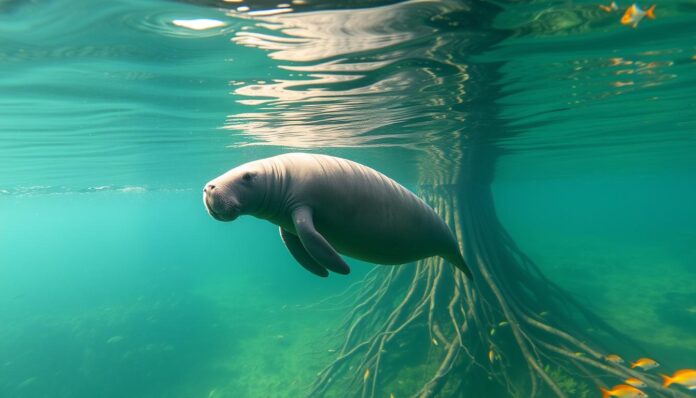Imagine meeting a huge marine creature that can weigh up to 1,200 pounds. Yet, it moves like a ballet dancer. Crystal River, Florida, is the only place in the US where you can legally swim with manatees. It offers a special scuba diving experience that draws people from all over.
These amazing sea cows are known for their calm nature and unique traits. Swimming with manatees lets you see these important animals in their home. Crystal River has the most manatees anywhere in the world.
Scuba diving with manatees is more than just an adventure. It’s a chance to help protect these vulnerable sea creatures. The Crystal River National Wildlife Refuge, created in 1983, is a key place for these animals. It keeps their home safe.
Key Takeaways – Diving with Manatees
- Crystal River is the only legal location in the US for manatee swimming
- Manatees are gentle marine mammals weighing up to 1,200 pounds
- The Crystal River National Wildlife Refuge protects these incredible creatures
- Manatee encounters offer unique wildlife interaction opportunities
- Responsible diving helps support marine conservation efforts
What Makes Manatees Special?
Manatees, known as sea cows, are amazing marine mammals. They are loved by nature lovers and those who care about marine conservation. These gentle giants live in both fresh and saltwater, making them unique.
These incredible creatures have special traits that make them stand out. Let’s look at what makes manatees truly special:
- Size and Weight: Manatees can grow up to 13 feet long and weigh between 1,000 to 3,500 pounds
- Lifespan: They can live up to 60 years in the wild
- Breathing Capacity: Manatees can hold their breath for approximately 20 minutes
- Swimming Speed: They typically glide at 5 mph but can burst up to 15 mph
Unique Physical Characteristics
Snorkeling with sea cows shows their amazing adaptations. They have thick, wrinkled skin and use their flexible tails to move. Their bodies are made for life in the water, with special ways to breathe in different environments.
Marine Conservation Challenges
Marine conservation is key for manatees to survive. There are about 6,000 Florida manatees left, facing threats from boats and losing their homes. Every year, 25% of manatee deaths are from boat accidents, showing how urgent it is to act.
Protecting manatees isn’t just about saving a species—it’s about preserving an entire marine ecosystem.
It’s important to have responsible eco-tourism and marine conservation. These efforts help protect these amazing creatures for the future.
Best Locations for Scuba Diving with Manatees
Finding the best spots for Florida manatee tours needs planning and knowing where they live. Crystal River diving is a top choice for those who love wildlife and want to see manatees up close.
Florida Springs and Rivers: A Manatee Paradise
The Gulf Coast of Florida is a top spot for manatee sightings. Crystal River, about 90 miles north of Tampa, is a safe place for them in winter.
- Kings Bay has over 40 freshwater springs
- The water stays at 72°F all year
- Up to 1,000 manatees come here in the coldest winter weeks
The best time to see manatees is from December to February. Weekdays are better for quiet encounters because there are fewer people.
The Caribbean and Beyond: Manatee Diving Destinations
Florida is the best place, but other areas offer great manatee experiences too. The Caribbean is a great choice for those who love the sea.
| Location | Manatee Sanctuary Details | Diving Opportunities |
|---|---|---|
| Belize | 3 Marine Reserves | Year-round tours available |
| Dominican Republic | Jaragua National Park | Seasonal diving opportunities |
Crystal River diving trips usually last 2-3 hours. Eco-tours are designed to protect manatees. The cost is around $100 per trip, making it a great deal for wildlife fans.
Asia:
- Indonesia – Raja Ampat: Known for its stunning biodiversity, Raja Ampat is home to a rich marine ecosystem that includes manatees. Exploring the crystal-clear waters of this archipelago offers a chance to encounter manatees amidst vibrant coral reefs and diverse marine life.
- Mozambique – Inhambane: Inhambane, located along the eastern coast of Mozambique, is a popular diving destination that occasionally provides opportunities to encounter manatees. Diving in the warm waters of this region allows for an exploration of its diverse marine environment.
Caribbean:
- Belize: Belize is renowned for its extensive network of mangrove forests and coastal areas that serve as vital habitats for manatees. Diving in Belize offers the chance to observe manatees in their natural environment while exploring the beautiful coral reefs of the Caribbean Sea.
- Mexico – Riviera Maya: The Riviera Maya region in Mexico, particularly areas such as Akumal and Cozumel, is known for its encounters with manatees. Snorkeling or diving in these locations allows for breathtaking encounters with these gentle giants amid vibrant underwater landscapes.
- Costa Rica – Tortuguero National Park: Located on the Caribbean coast of Costa Rica, Tortuguero National Park is home to a significant population of manatees. Diving in this region offers the opportunity to observe manatees while exploring the intricate network of canals and mangrove forests.
- Netherlands – Oosterschelde: The Oosterschelde estuary in the Netherlands is a unique diving destination where occasional encounters with manatees have been reported. Exploring the submerged reefs and seagrass beds of this region can provide surprising encounters with these gentle giants.
- Australia – Moreton Bay: Moreton Bay, located off the coast of Brisbane in Queensland, Australia, is a known habitat for manatees, locally known as dugongs. Diving in this area offers the chance to encounter these fascinating creatures while exploring the diverse marine life of the bay.
- United States – Crystal River, Florida: Crystal River in Florida is a popular destination for diving with manatees. Its warm and clear springs attract manatees during the winter months, providing divers with the incredible opportunity to observe and interact with them in their natural habitat.
- Brazil – Amazon River: The Amazon River basin in Brazil is home to a unique species of manatee called the Amazonian manatee. While diving in this region may present challenges due to limited visibility, encounters with these elusive creatures can be an unforgettable experience.
Please note that manatee encounters are dependent on various factors, including seasonal variations and the natural behavior of manatees. It is essential to consult with local authorities, dive operators, or experienced guides to determine the best times and locations for encountering manatees in each region.
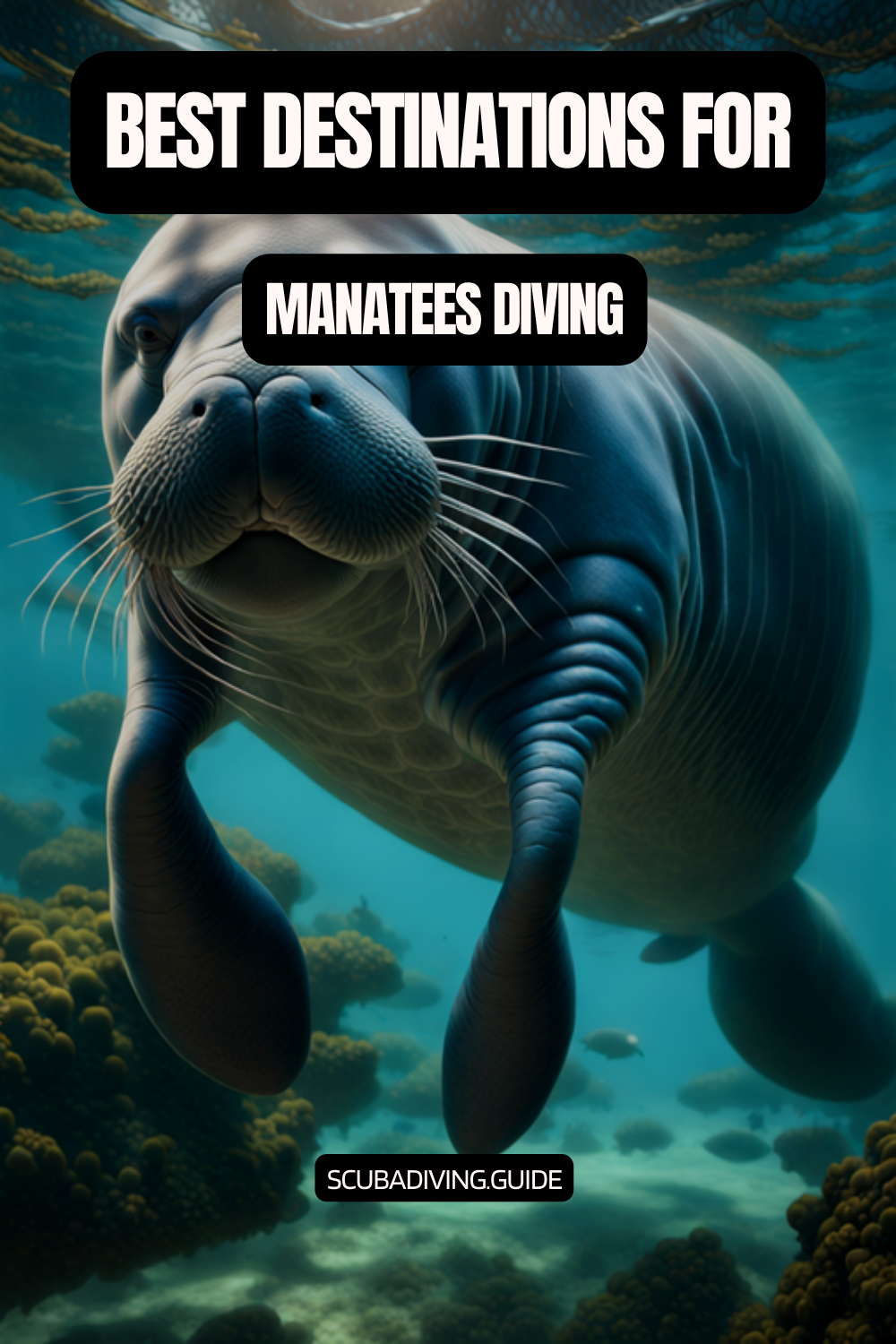
When is the Best Time to Dive with Manatees?
Planning warm water adventures with manatees needs careful timing. You must understand their seasonal patterns. The best times for diving with these gentle creatures are during specific months.
Seasonal Migration Patterns
Manatees are very sensitive to temperature. They seek warm waters to survive. From November to March, they gather in certain places to stay warm.
Crystal River, Florida, is a top spot for manatee sightings. It’s perfect for those who love sustainable travel.
- Peak season: November to March
- Winter congregations: Thousands of manatees migrate to warm springs
- Summer population: Approximately 40-100 manatees present
Weather Considerations
Water temperature is key for manatee diving. They like waters around 72°F (22°C). Florida’s natural springs keep this temperature all year.
| Month | Manatee Population | Recommended Diving Time |
|---|---|---|
| December-February | Highest concentration | Early morning tours |
| Summer months | Reduced numbers | Limited viewing opportunities |
For the best experience, dive in the morning, around 6 a.m. Manatees are most active then. Companies like River Ventures and Bird’s Underwater offer special tours. They provide a close and respectful way to see these amazing creatures.
Preparing for Your Manatee Diving Adventure
Scuba diving with manatees needs careful planning and respect for these gentle creatures. Eco-tourism means we must act responsibly to protect both divers and the sea. Before you dive, knowing the right gear and safety rules is key.
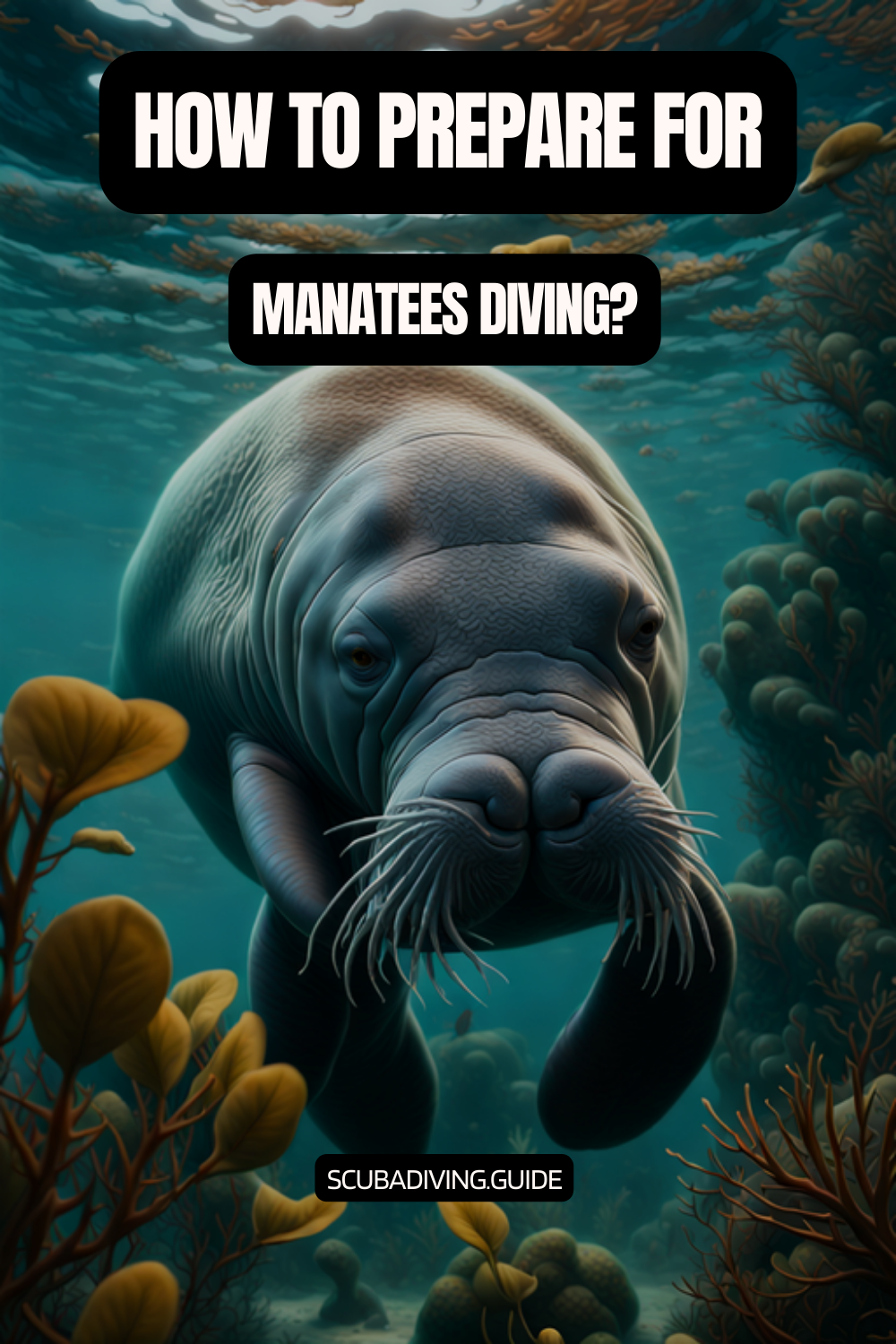
Essential Gear for Scuba Diving
Having the right equipment makes your manatee dive safe and fun. Here’s what you’ll need:
- Full-length wetsuit (available in multiple sizes)
- Mask and snorkel
- Underwater camera
- Fins with controlled movement
- Thermal protection layers
Safety Guidelines to Consider
Manatees are protected by laws, so we must interact with them wisely. Here are important rules to follow:
- Maintain a respectful distance from manatees
- Never chase or touch the animals
- Control your buoyancy carefully
- Listen to certified in-water guides
- Minimize fin movements in shallow areas
*”Relax and float – let the manatees approach you naturally.”*
| Safety Aspect | Recommendation |
|---|---|
| Water Temperature | 72 degrees Fahrenheit (constant) |
| Tour Duration | Approximately 3 hours |
| Average Water Time | 30 minutes |
| Guide Certification | USCG Master Captain |
By sticking to these rules, you help make eco-tourism sustainable. And you’ll have a memorable time with these amazing creatures.
Understanding Manatee Behavior
Manatee watching gives us a peek into their fascinating world. These gentle marine mammals have complex behaviors. They fascinate both marine conservation experts and wildlife lovers.
Manatees are very social and smart. They have traits that make them stand out from other sea creatures. Their curiosity and gentle nature make them great subjects for underwater watching.
Respectful Manatee Interactions
When watching manatees, divers need to follow important rules. These rules help ensure safe and respectful interactions:
- Move slowly and deliberately underwater
- Allow manatees to initiate contact
- Maintain a calm and quiet demeanor
- Never chase or touch manatees
- Observe from a safe distance
Debunking Manatee Myths
There are many myths about these marine mammals. Let’s look at some common ones:
- Myth: Manatees are aggressive – In reality, they are peaceful herbivores
- Myth: Manatees are always slow – They can reach speeds up to 15 miles per hour in short bursts
- Myth: Manatees have no predators – They face threats from human activities and habitat loss
Understanding manatee behavior is key for marine conservation. These amazing creatures are vital to our oceans. They deserve our respect and protection during manatee watching experiences.
The Scuba Diving Experience Explained
Crystal River diving is an amazing underwater adventure. It lets you meet gentle marine giants up close. Florida manatee tours are a special chance to see these incredible creatures in their home.
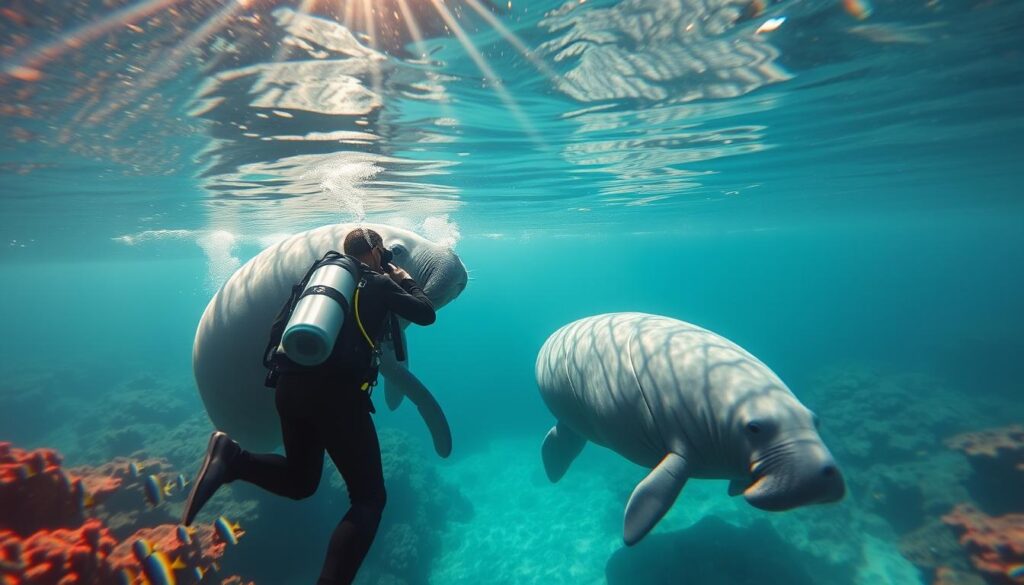
Before your manatee encounter, it’s good to know what to expect. The Crystal River National Wildlife Refuge is the best place for these amazing experiences.
What to Expect on the Dive
Divers will have an incredible underwater journey. Here are some key things to look out for:
- Water temperatures are always around 72 degrees Fahrenheit.
- Visibility can be crystal clear or a bit tannic.
- You might see many manatees during peak season.
The Role of Guides in Your Adventure
Professional guides are key for a safe and fun dive in Crystal River. They help by:
- Telling you about manatee behavior and how to interact with them.
- Making sure everyone is safe and the wildlife is protected.
- Teaching you about the local marine ecosystem.
| Dive Location | Typical Visibility | Manatee Population |
|---|---|---|
| Kings Bay | 10-15 feet | 100-300 manatees |
| Three Sister Springs | 20-30 feet | 50-150 manatees |
| Rainbow River | 50-60 feet | 30-100 manatees |
Pro tip: Book your Florida manatee tours on weekdays for less crowded and more intimate wildlife interactions.
Photography Tips While Diving with Manatees
Capturing the magic of manatee encounters needs skill, patience, and respect. Underwater photography is special and can make your trip unforgettable.
How to Capture Stunning Underwater Images
Manatee photography requires special techniques and gear. Here are key tips for amazing photos:
- Use a fisheye lens to show the manatee’s size and the underwater world
- Go for sunny days for the best light near the surface
- Stay a few feet from the surface for clear images
- Take photos when manatees come up to breathe, every 15-20 minutes
Responsible Photography Practices
Respecting manatees is key. Follow these important rules:
- Keep at least 6 feet away from manatees
- Don’t use flash in protected areas
- Don’t touch or disturb the manatees
- Follow local rules in places like Crystal River and Homosassa River
Professional tour operators offer great photography services. They let you enjoy the experience while ensuring you interact responsibly with manatees.
Supporting Manatee Conservation Efforts
Marine conservation is key to protecting the gentle sea cows we love. Eco-tourism is a great way to help manatee preservation. It lets us see these amazing creatures in their home.
Diving with manatees is more than just an amazing experience. It helps fund important conservation work. By picking responsible tour operators, you help protect these marine mammals.
How Diving Supports Conservation
- Generates funding for research and protection programs
- Raises public awareness about manatee conservation
- Supports local economies that prioritize wildlife protection
- Helps monitor manatee populations and habitats
Key Organizations Protecting Manatees
The Save the Manatee Club leads in protecting manatees. They do a lot to help:
- Legal challenges against projects threatening manatee habitats
- Advocating for federal protection laws
- Establishing boat speed zones and safe havens
- Educational programs and public awareness campaigns
Divers can make a difference by supporting these organizations through donations, volunteer work, and spreading awareness about manatee conservation. Your underwater adventure can help protect these remarkable marine mammals.
Every dive is an opportunity to become a marine conservation ambassador.
Testimonials from Scuba Divers
Scuba diving with manatees turns simple water trips into unforgettable memories. Divers from all over the United States share their amazing manatee encounters. They talk about the magical warm water adventures that leave a lasting impact.
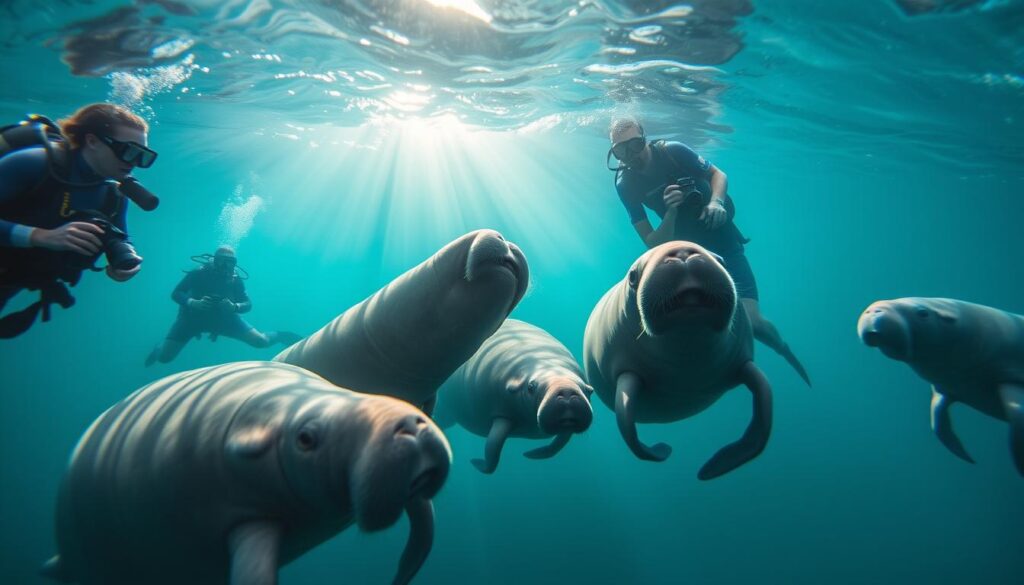
Experienced divers share what makes their manatee encounters so special. They explain why these experiences are truly unforgettable:
- Crystal River offers an unparalleled environment for seeing manatees in their natural home
- The water stays at a perfect 72 degrees, making it ideal for marine life
- Visitors often see mothers with their calves in safe spring areas
Memorable Encounters Shared
“Our manatee tour was extraordinary! We saw many manatees, including playful calves, in the crystal-clear waters of Kings Bay. The guides were incredibly knowledgeable about manatee behavior and conservation.”
Expert Diver Advice
Veteran divers offer some key tips for the best manatee encounters:
- Book tours during peak season (November-April)
- Choose early morning tours for less crowded experiences
- Respect manatee habitats and follow guide instructions carefully
- Bring underwater camera equipment to capture memories
With less than 5,000 manatees left in the United States, these warm water adventures are not just incredible. They also help support marine conservation efforts.
Common Marine Species Found Alongside Manatees
When diving with manatees, you are likely to encounter a diverse array of marine species that share their habitat. From vibrant fish species to fascinating invertebrates, the underwater world surrounding manatees is teeming with life. Let’s explore some of the common marine species you may encounter while diving with manatees.
- Fish Species: The marine ecosystems where manatees reside are often home to an abundance of fish species. These include colorful tropical fish such as angelfish, parrotfish, butterflyfish, and surgeonfish. You may also spot schools of vibrant damselfish, wrasses, and triggerfish. Larger predators like barracudas and groupers might be present as well, patrolling the reefs or seagrass beds in search of prey.
- Sea Turtles: Sea turtles are often found in the same habitats as manatees, as they both rely on seagrass beds for food. Green sea turtles and loggerhead sea turtles are commonly spotted, gracefully swimming through the water or peacefully grazing on seagrass. Observing these majestic creatures alongside manatees adds to the wonder of the underwater experience.
- Rays: Several species of rays can be encountered while diving with manatees. The graceful movements of spotted eagle rays or southern stingrays gliding through the water are a captivating sight. These flat-bodied creatures often frequent sandy areas or coral reefs, using their specialized mouths to feed on small invertebrates in the sand or among the coral.
- Dolphins: Although not as commonly seen as other species, dolphins occasionally share the same habitat as manatees. Dolphins are highly intelligent and social mammals known for their acrobatic displays and playful behavior. If you’re fortunate, you may witness dolphins gracefully swimming alongside manatees, creating a truly mesmerizing spectacle.
- Invertebrates: The marine environments where manatees reside are also home to a rich diversity of invertebrates. Vibrant corals, sponges, and sea anemones create a colorful backdrop for the underwater landscape. Delicate seahorses may be spotted clinging to seagrass, blending seamlessly with their surroundings. Other fascinating invertebrates such as starfish, sea cucumbers, and various species of crustaceans also contribute to the vibrant ecosystem.
- Birds: While not strictly marine species, various bird species can be found near manatee habitats. Coastal areas or mangrove forests often serve as nesting sites or feeding grounds for different bird species. You may spot wading birds like herons and egrets, ospreys soaring above the water, or pelicans diving for fish.
Encountering these common marine species alongside manatees adds to the richness and diversity of the underwater experience. Observing the intricate interactions between these species provides a deeper understanding of the interconnectedness of marine ecosystems and the importance of preserving their delicate balance.
Conclusion: Why You Should Dive with Manatees
Scuba diving with manatees is more than an adventure. It’s a journey into marine conservation. Crystal River lets you legally swim with wild manatees. This experience connects you with nature’s gentle marine mammals.
This travel experience is sustainable. It goes beyond just tourism. It creates a direct link between humans and wildlife conservation.
Your manatee encounter has a big impact. By diving responsibly, you join a critical conservation movement. Human activities cause half of West Indian manatee deaths.
Each responsible interaction raises awareness. The Three Sisters Springs Refuge is a 57-acre sanctuary. It shows how tourism can support wildlife preservation.
By diving with manatees, you become a marine life advocate. You learn about their amazing traits. They eat 10% of their body weight daily and live in warm springs.
Your experience can inspire others to support conservation. It helps them understand the importance of marine ecosystems.
Diving with manatees is a chance to make a difference. Whether you visit during peak season or explore Crystal River, you’ll make lasting memories. You’ll also support vital wildlife preservation efforts.
FAQ – Diving with Manatees
Are manatee diving experiences safe for beginners?
Yes, diving with manatees is safe for beginners. In Crystal River, Florida, you’ll find guided tours with expert instructors. They give detailed safety briefings and support. Snorkeling is great for first-timers because it’s easier and lets you interact with manatees.
What is the best time of year to dive with manatees?
The best time is from November to March when it’s cooler. Manatees gather in warm spots during this time. Crystal River and other Florida areas are perfect for seeing them. This season offers the best chance to see many manatees.
Do I need special certification to dive with manatees?
You don’t need advanced scuba certification, but you should be comfortable in the water. Many tours are designed for different skill levels. Some places require a short briefing on how to interact with manatees responsibly.
What equipment do I need for a manatee diving experience?
You’ll need a wetsuit, mask, snorkel, and fins. Many tours provide this gear, but bringing your own is better. If you want to take photos, waterproof cameras or housings are good. Choose eco-friendly gear to protect the environment.
How close can I get to the manatees?
You must keep a safe distance from manatees. Stay at least 6 feet away and avoid sudden movements. Tour guides will teach you how to do this safely.
Are manatee encounters guaranteed?
While places like Crystal River have a high chance of seeing manatees, it’s not guaranteed. Water temperature, season, and wildlife patterns affect their presence. Booking with reputable operators during peak season increases your chances.
How can I contribute to manatee conservation during my dive?
Choose eco-friendly tour operators and follow all guidelines for interacting with wildlife. Donating to organizations like Save the Manatee Club helps. Educating others and respecting their habitat also makes a difference.
What should I know about manatee behavior underwater?
Manatees are usually gentle and curious. They might come closer but shouldn’t be touched or chased. Understanding their body language and moving calmly is key. They’re social and may play when they feel safe.
Can children participate in manatee diving experiences?
Many tours are family-friendly, starting at 5-6 years old. Snorkeling is better for kids than scuba diving. Always check the tour provider’s age and skill requirements.
What is the average cost of a manatee diving experience?
Prices vary, from $50 to $150 per person. In Crystal River, Florida, expect to pay $75-$100 for a 2-3 hour tour. Prices change with the season, group size, and extra services.
